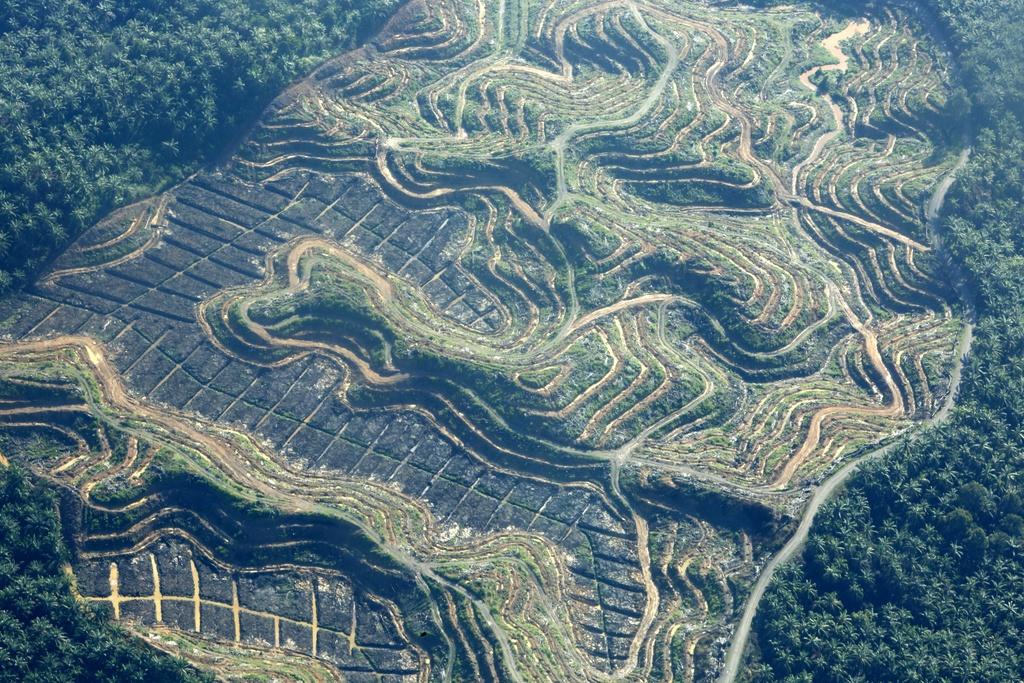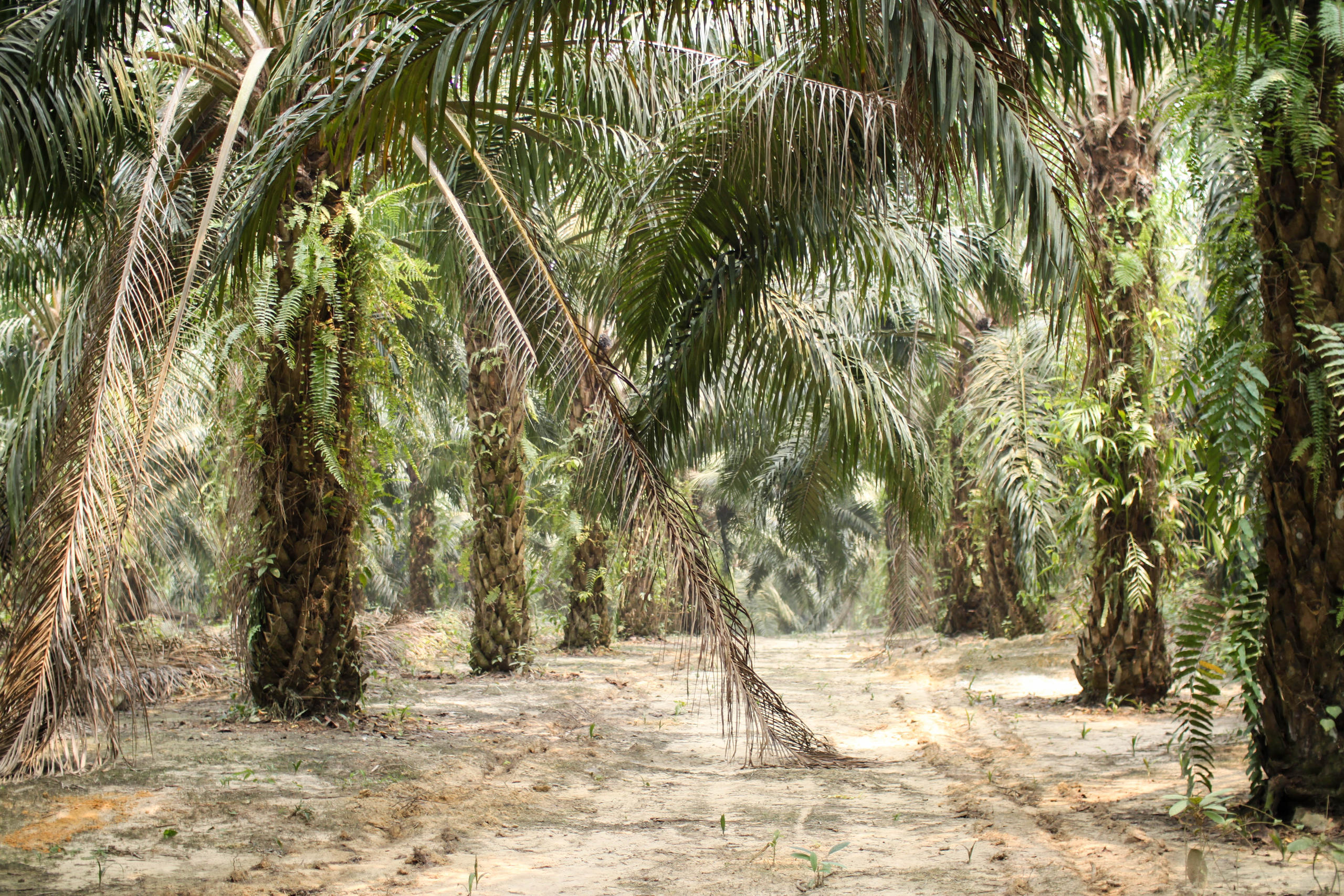
Can Nestlé monitor its palm oil from the sky?

Nestlé has offered journalists a sneak peek into the satellite technology it is using to monitor its palm oil supply chain. Yet despite moves towards more transparency over deforestation, it is unlikely to be made available to consumers anytime soon.
The presentation of the Starling satellite technology took place on Monday at the highly secure Airbus complex in Toulouse, France. Airbus and Nestlé have been working on developing the satellite monitoring service since the latter joined the Consumer Goods Forum’s pledgeExternal link to achieve zero net deforestation by 2020.
An Airbus representative zoomed into satellite imagery of forests and palm oil plantations in Indonesia to show what Starling was capable of. Given that Airbus’ satellites can zoom in on a target as small as 1.5m, it was fairly easy to distinguish palm oil plantations from forests. If in doubt, algorithms distinguish palm oil trees from rubber and other crops by colouring the former yellow, and the latter maroon.
Patches of red showed areas where forests had recently been cut. Whenever this happens within a 50km radius of one of the 1,257 mills throughout the world that supply Nestlé, a push notification is sent. Nestlé then must contact the supplier in question, who will have to prove that the forest clearing had nothing to do with them.
“Around 60% of our suppliers have received a phone call from us,” says Benjamin Ware, Nestlé’s global head for responsible sourcing.
.@swissinfo_enExternal link gets a sneak peek into Nestlé’s palm oil satellite monitoring platform Starling developed with Airbus. pic.twitter.com/CZdSKiPT7sExternal link
— Anand Chandrasekhar (@anand_csekhar) April 30, 2019External link
A failure to account for the deforestation picked up by satellites could get the supplier temporarily suspended from Nestlé’s order book. So far ten suppliers, accounting for 5% of Nestlé’s total palm oil needs, have been blacklisted.
“A combination of satellite imagery, boots on the ground and certification allows us to claim that 77% of our commodities are deforestation free,” says Magdi Batato, Nestlé’s head of operations.
For the suppliers, it means more oversight from Nestlé.
“It complements what we are doing on the ground. Nestlé tells us where deforestation is happening and we can discuss who is responsible because we have the traceability,” Ian Suwarganda of Golden Agri-Resources, a Nestlé palm oil supplier, told swissinfo.ch.
Suwarganda claims his company can trace 62% of the palm oil they supply to the plantations.
“Where we have some concerns is the issue of immediate suspension if deforestation is found. I think both parties are clear that exclusion is not the answer,” says Suwarganda.
Public access
On Tuesday, Nestlé launched a transparency dashboardExternal link on its website that contains information on deforestation in its palm oil supply chain based on Starling data. The dashboard represents a fraction of the immense amount of data on palm oil concessions that Nestlé has access to. The company has a vision to eventually make parts of the Starling imagery accessible to consumers. Currently, the contract with Airbus stipulates sole use only.
“The system itself is built to share information. It is the mixing of information that belongs to Airbus like satellite imagery and that which belongs to a customer like Nestlé that requires an agreement on what can be shown and shared,” François Lombard, head of intelligence business at Airbus, told swissinfo.ch.
Can consumers trust Nestlé to accurately share information picked up by satellites when it comes to deforestation caused by its palm oil suppliers?
“What would Nestlé gain by taking the risk of lying which could be discovered later? The objective is to gain trust, not to lose it,” Bastian Sachet of Earthworm, a consultancy that also contributed to the Starling platform, told swissinfo.ch.
For him, Nestlé might be open to giving a few NGOs access to Starling on a case by case basis. While the long-term vision is to give consumers access to the imagery, there are many hurdles to overcome before it becomes a reality.
Smallholder problem
The Starling platform also allows one to see the boundaries of plantations – purple for government-allotted concessions, blue for privately-owned – helping to narrow down the culprits of deforestation. But no boundary maps exist for smallholders that account for 20% of Nestlé’s palm oil supply chain.
To track deforestation by smallholders Nestlé depends on suppliers and mills knowing where their palm oil comes from. But this is seldom the case, and thus presents another hurdle to Nestlé’s goal to be deforestation-free by 2020. The company hopes that by placing the onus on suppliers to prove deniability when satellites pick up forest cutting, they will get a better grip on where their palm oil is coming from. However, cracking down on small farmers is not a good look.
“Nestlé as a buyer focuses more on high deforestation rate areas of large size and not small subsistence farming,” says Ware.

More
Swiss study highlights environmental impact of palm oil plantations

In compliance with the JTI standards
More: SWI swissinfo.ch certified by the Journalism Trust Initiative
































You can find an overview of ongoing debates with our journalists here . Please join us!
If you want to start a conversation about a topic raised in this article or want to report factual errors, email us at english@swissinfo.ch.